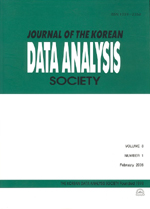다요인 상호작용 존재가능시의 자료의 일반화 선형 모형화를 위한 모형 항 선택 방법론
A Model-Term Selection Methodology for Generalized Linear Modeling of Data when Multifactor Interactions can Exist
- 한국자료분석학회
- Journal of The Korean Data Analysis Society (JKDAS)
- Vol.9 No.6
-
2007.122969 - 2984 (16 pages)
- 2

자료의 모형화에서 추구하는 두 가지 중요 기준은 모형의 적합도와 간결성이라고 할 수 있는데, 모형화의 주요 목적에 따라서 각 기준에 대한 우선순위를 정하게 될 것이다. 모형화의 주요 목적이 특정 조건에서의 반응 기대치에 대한 예측이라면 적합도에 우선순위 1을 주게 될 것이고, 모형화의 주요 목적이 반응 시스템의 핵심 구조에 대한 이해라면 간결성에 우선순위 1을 주게 될 것이다. 본 논문은 다요인 상호작용들이 존재가능한 경우에 자료를 일반화 선형 모형화할 때 이용될 수 있는, 모형화의 주요 목적에 따른 모형 항 선택 방법론을 제안한다. 이 방법론에서는 계층구조 원리가 준수되고 적합결여 검정이 사용된다. 실제 자료의 Logit 모형화와 Loglinear 모형화에의 이 방법론의 적용도 예시한다.
Two important criteria that are pursued in data modeling are a model s goodness of fit and parsimony. The priority for each of the two criteria will be determined according to the main purpose of modeling. The criterion of goodness of fit will be given priority 1 if the main purpose of modeling is the prediction of the expected response under certain conditions. The criterion of parsimony will be given priority 1 if the main purpose of modeling is the understanding of the core structure of the response system. This article suggests a model-term selection methodology according to the main purpose of modeling for generalized linear modeling of data when multifactor interactions can exist. In this methodology, the hierarchy principle is observed and the lack-of-fit test is used. Logit and loglinear modelings of some real data are illustrated.
1. 서론
2. 모형의 적합도가 간결성보다 더 중요할 때의 모형 항 선택 방법
3. 모형의 간결성이 적합도보다 더 중요할 때의 모형 항 선택 방법
4. 맺음말
참고문헌
(0)
(0)